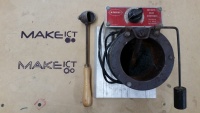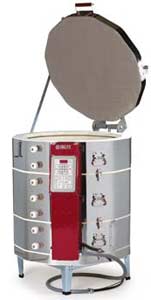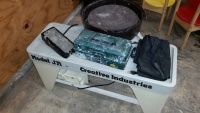Difference between revisions of "Ceramics Area"
m |
|||
| Line 2: | Line 2: | ||
The ceramics studio is an enclosed air conditioned space and is approximately 375 square feet. John Cody is the Ceramics Area Lead. [[User:Patrick Hutchison|Patrick Hutchison]] and Scott Sullivan are the Ceramics Area Assistant Leads. | The ceramics studio is an enclosed air conditioned space and is approximately 375 square feet. John Cody is the Ceramics Area Lead. [[User:Patrick Hutchison|Patrick Hutchison]] and Scott Sullivan are the Ceramics Area Assistant Leads. | ||
| − | If you have questions, put a post on the forum, or send us an email: [mailto:ceramics@makeict.org ceramics@makeict.org] | + | If you have questions, put a [https://talk.makeict.org/c/ceramics post on the forum], or send us an email: [mailto:ceramics@makeict.org ceramics@makeict.org] |
Clay when mixed with proper amounts of H2O becomes a plastic substance. It is made from alumina and silica. It may or may not have other additives. When dried and heated to extreme temperatures it loses its plasticity. It can be coated with silica or clay based emulsions that when dried and reheated to extreme temperatures creates a permanent surface. Clay is useful for all kinds of things limited only by your imagination. It can be a toilet or the basic component in makeup. It can be a coffee cup or a tile on a space shuttle. | Clay when mixed with proper amounts of H2O becomes a plastic substance. It is made from alumina and silica. It may or may not have other additives. When dried and heated to extreme temperatures it loses its plasticity. It can be coated with silica or clay based emulsions that when dried and reheated to extreme temperatures creates a permanent surface. Clay is useful for all kinds of things limited only by your imagination. It can be a toilet or the basic component in makeup. It can be a coffee cup or a tile on a space shuttle. | ||
Revision as of 18:18, 3 April 2018
Contents
General Information
The ceramics studio is an enclosed air conditioned space and is approximately 375 square feet. John Cody is the Ceramics Area Lead. Patrick Hutchison and Scott Sullivan are the Ceramics Area Assistant Leads.
If you have questions, put a post on the forum, or send us an email: ceramics@makeict.org
Clay when mixed with proper amounts of H2O becomes a plastic substance. It is made from alumina and silica. It may or may not have other additives. When dried and heated to extreme temperatures it loses its plasticity. It can be coated with silica or clay based emulsions that when dried and reheated to extreme temperatures creates a permanent surface. Clay is useful for all kinds of things limited only by your imagination. It can be a toilet or the basic component in makeup. It can be a coffee cup or a tile on a space shuttle.
Ceramics Studio Access Policy
Every member 12 or older shall have access to the clay studio. Members under 12 shall have access with a member adult to supervise. No one under 10, without prior experience, shall have access to the wheels used for throwing. Guests need to have a member present.
No access to kiln area shall be permitted without authorization. Authorization shall consist of the following training.
Bisque firing
Have basic knowledge of how to handle dry clay. Have an understanding of how the kiln works at bisque temperatures. Be present twice to watch loading of bisque firing and the process involved in starting the kiln. Be supervised twice while loading and firing the bisque.
Glaze firing
Must be authorized in Bisque firing. Have basic knowledge of glaze materials and what happens to them as they melt. Have an understanding of how the kiln works at glaze temperatures. Be present once to watch the loading process firing and the process involved in starting the kiln. Be supervised three times while loading and firing a glaze firing.
We are building a library of sample tiles to show what different glazes look like. This will help folks, especially first timers, get an idea of what the finished glaze will look like on their work. The tiles will be hung up in the studio and you can reference the spreadsheet to see the details about the glaze used.
Equipment training
Individuals will need a single training session to use all other clay studio equipment. This includes the wheels, the extruder, and any other equipment the Area Lead feels is necessary.
During workshops, classes, etc. access maybe limited due to space availability.
Equipment List
| Picture | What | Manufacturer | Model | Power | Status | Expert | How To |
|---|---|---|---|---|---|---|---|
 |
Melter and Ladle | Lee | 110 | Works | James S? | instructions | |
 |
Electric Kiln | Skutt | Model-K | 220 | Works | Susan DeWit | |
 |
Pottery Wheel | Creative Industries | Model JR | 110 | ? | Sean Whalen | |
 |
Slab Roller | Northstar | n/a | Works | John Cody |
